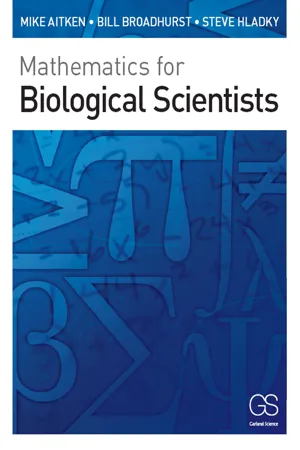
- 482 pages
- English
- ePUB (mobile friendly)
- Available on iOS & Android
Mathematics for Biological Scientists
About this book
Mathematics for Biological Scientists is a new undergraduate textbook which covers the mathematics necessary for biology students to understand, interpret and discuss biological questions.
The book's twelve chapters are organized into four themes. The first theme covers the basic concepts of mathematics in biology, discussing the mathematics used in biological quantities, processes and structures. The second theme, calculus, extends the language of mathematics to describe change. The third theme is probability and statistics, where the uncertainty and variation encountered in real biological data is described. The fourth theme is explored briefly in the final chapter of the book, which is to show how the 'tools' developed in the first few chapters are used within biology to develop models of biological processes.
Mathematics for Biological Scientists fully integrates mathematics and biology with the use of colour illustrations and photographs to provide an engaging and informative approach to the subject of mathematics and statistics within biological science.
Frequently asked questions
- Essential is ideal for learners and professionals who enjoy exploring a wide range of subjects. Access the Essential Library with 800,000+ trusted titles and best-sellers across business, personal growth, and the humanities. Includes unlimited reading time and Standard Read Aloud voice.
- Complete: Perfect for advanced learners and researchers needing full, unrestricted access. Unlock 1.4M+ books across hundreds of subjects, including academic and specialized titles. The Complete Plan also includes advanced features like Premium Read Aloud and Research Assistant.
Please note we cannot support devices running on iOS 13 and Android 7 or earlier. Learn more about using the app.
Information

The authors, Mike, Steve, and Bill, holding a protein sample destined for the 500 MHz NMR spectrometer in the background. Image courtesy of Mike Aitken, Bill Broadhurst, and Steve Hladky.

In elementary arithmetic, we may have thought of ☐ as just a space holder to tell us where to write the answer, but it can also be regarded as a symbol that stands for a number whose value is not already known.
(EQ1.1) |
(EQ1.2) |
Table of contents
- Cover
- Half Title
- Title Page
- Copyright Page
- Table of Contents
- Preface
- Introduction
- Chapter 1 Quantities and Units
- Chapter 2 Numbers and Equations
- Chapter 3 Tables, Graphs, and Functions
- Chapter 4 Shapes, Waves, and Trigonometry
- Chapter 5 Differentiation
- Chapter 6 Integration
- Chapter 7 Calculus: Expanding the Toolkit
- Chapter 8 The Calculus of Growth and Decay Processes
- Chapter 9 Descriptive Statistics and Data Display
- Chapter 10 Probability
- Chapter 11 Statistical Inference
- Chapter 12 Biological Modeling
- Answers to End of Chapter Questions
- Appendices
- Index